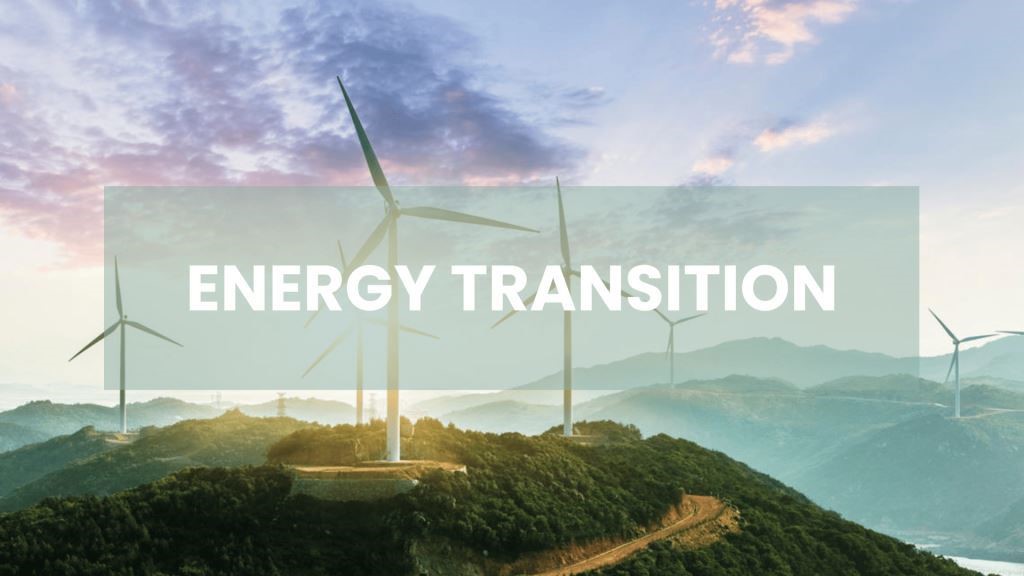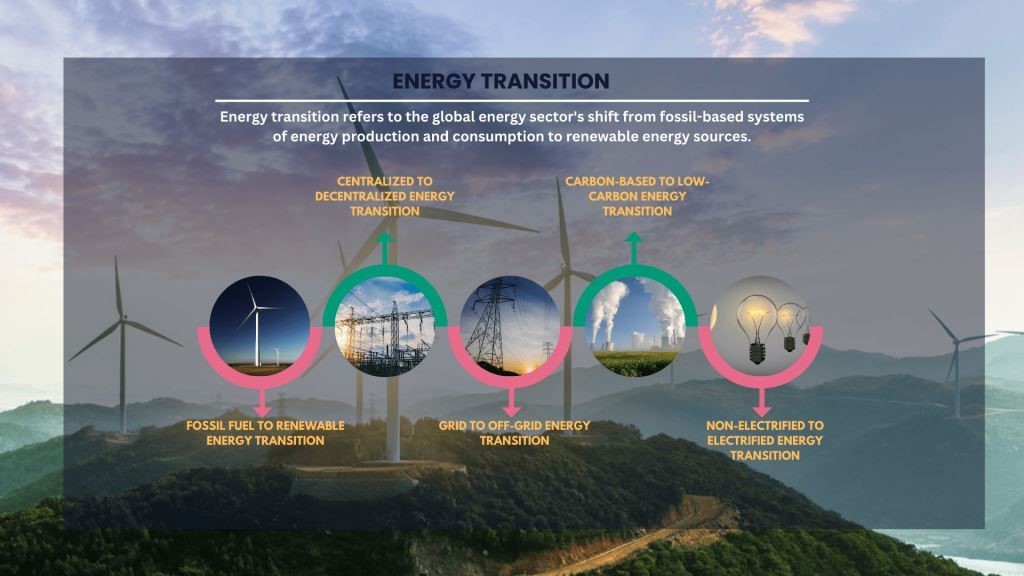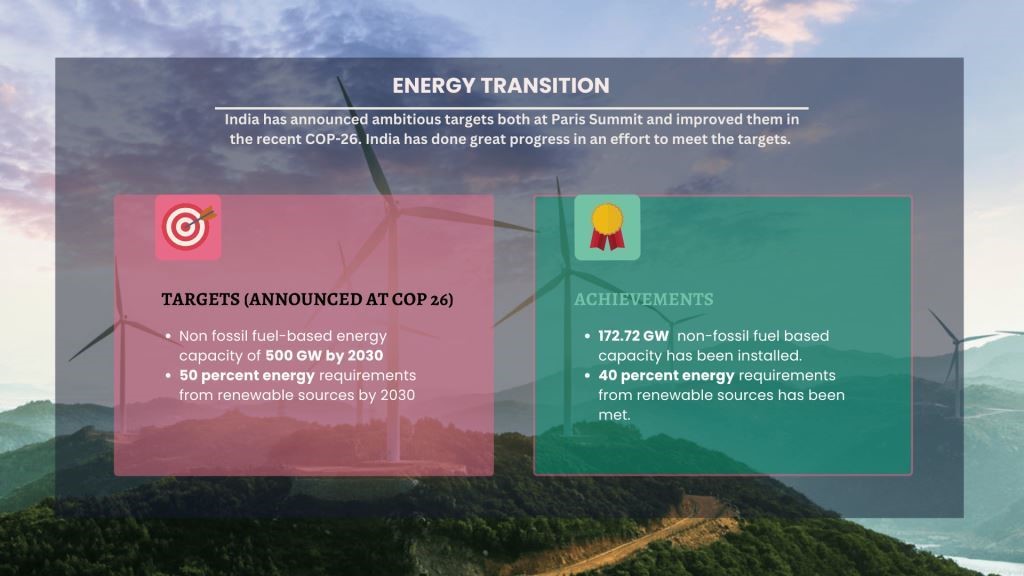03 Apr ENERGY TRANSITION
ENERGY TRANSITION
This article covers “Daily Current Affairs for UPSC” and the topic details Energy Transition. With the negative effects of climate change (happening primarily because of fossil fuel-based energy sources such as coal) visible in forms of adverse climatic conditions the need for energy transition has become critical. The topic “Energy Transition” has relevance in the Environment section for the UPSC CSE exam.
Relevance of Energy Transition for UPSC CSE Exam
For Prelims:
- About Energy Transition.
- Types
For Mains:
- GS 3: Environment
- Need for Energy Transition
- Government’s emphasis on it.
- Progress over the years.

Energy Transition
What is Energy Transition?
Energy transition refers to the global energy sector’s shift from fossil-based systems of energy production and consumption to renewable energy sources.
FOSSIL-BASED SYSTEMS —> RENEWABLE ENERGY SOURCES

The energy transition
What is the need for Energy Transition?
Energy transition has caught the attention of global policymakers who are constantly putting efforts so that the existing energy sources and processes can be changed into a more sustainable energy system. The need for transition arises freon the following changes that have occurred:
- Climate Change: The use of fossil fuels to power homes, businesses, and transportation is the leading cause of greenhouse gas emissions, which is the main driver of climate change. It is critical in mitigating climate change.
- Mitigating the impacts of climate change: Climate change comes with negative consequences like extreme weather events like floods, droughts, and fluctuating temperatures. This is critical in mitigating extreme weather events.
- Energy Security: The reliance on fossil fuels makes countries vulnerable to price volatility and geopolitical instability. This process can increase energy security and reduce dependence on foreign energy sources.
- Improving Air Quality: Fossil fuel combustion produces harmful air pollutants that contribute to respiratory illnesses, premature death, and environmental damage. Energy Transition can improve air quality, particularly in urban areas.
- Economic Opportunities: This process can create new jobs and spur economic growth in sectors such as energy efficiency, renewable energy development, and electric vehicle production. The growth in these sectors means the new age employment opportunities and also carries a spillover effect on other sectors of the economy.
What are the types of Energy Transition?
- Fossil fuel to renewable energy transition: This involves moving away from traditional sources of energy like coal, oil, and gas, and transitioning to renewable sources such as wind, solar, hydro, geothermal, and biomass.
- Centralized to decentralized transition: This involves shifting from a centralized energy system where power is generated in large power plants and transmitted over long distances to a decentralized system where power is generated closer to where it is consumed, using small-scale renewable energy systems like rooftop solar panels or small wind turbines.
- Grid to off-grid transition: Moving away from the traditional electrical grid system and transitioning to a more localized, off-grid energy system, where homes, businesses, and communities generate their power using renewable energy sources.
- Carbon-based to low-carbon: This involves reducing the number of carbon emissions generated by the energy sector, using cleaner, low-carbon energy sources like solar, wind, and nuclear power.
- Non-electrified to electrified energy transition: This involves bringing electricity to areas that currently lack access to it, by transitioning from non-electrified energy sources like kerosene lamps and diesel generators to renewable energy sources like solar and wind power.
The Government’s emphasis
Green growth is an important pillar in India’s energy transition model. The government has formed a target of 500 GW of renewable energy to be produced by 2030.
FM Nirmala Sitharaman underlined the government’s emphasis on the country’s net-zero targets (to be achieved by 2070). She emphasized Green Growth as one of the Saptarishis (seven points) in the Amrit Kaal Budget.
- Setting up battery energy storage of 4,000 MwH through viability gap funding.
- National Green Hydrogen Mission launched on January 4, 2023, with an initial outlay of Rs 19,700 crore.
- Rs 35,000 crore for priority capital investment towards energy transition and net zero objectives.
Rs. 70,000 crores for specific initiatives
- 19,700 crores for Green Hydrogen,
- 35000 crores for energy transition,
- 20,700 crores for renewable energy evacuation.
What are the targets and progress and progress made in the area of Energy Transition?

Energy transition in India
India has made significant progress in the area of energy transition in recent years. Some of the key developments include:
- Renewable Energy Capacity: India has announced that it aims to achieve net zero by 20270 as announced in COP-2, 26.
a) India has set an ambitious target of achieving 500 GW of renewable energy capacity by 2030.
b) As of 2021, India had installed more than 172 GW of renewable energy capacity, with solar and wind energy accounting for the majority of this capacity.
- Energy Efficiency: It means using the same energy source in such a way that the energy consumption is less and the savings are more. The government of India has implemented several energy efficiency measures such as:
a) UJALA scheme provides energy-efficient LED bulbs at subsidized rates.
b) Perform Achieve and Trade (PAT) scheme incentivizes industries to improve energy efficiency through an incentive-based approach.
c) Solar and Wind policy.
- Electric Mobility: The government of India has launched several initiatives to promote electric
mobility:
a) The faster Adoption and Manufacturing of Electric Vehicles (FAME) scheme provides incentives for electric vehicle adoption.
b) National Electric Mobility Mission Plan (NEMMP) to achieve 30% electric vehicle penetration by 2030.
- Policy Reforms: The Indian government has implemented several policy reforms to support the energy transition, such as:
a) Competitive bidding for renewable energy projects,
b) Removal of subsidies on fossil fuels.
c) Implementation of a national carbon tax.
- International Cooperation: India has also engaged in international cooperation to support the
energy transition, such as:
International Solar Alliance and OSOWOG, which aims to promote solar energy adoption in developing countries.
Source:
Daily Current Affairs for UPSC
Reading Daily Current Affairs should be a fundamental habit for passing the UPSC examination. For gaining a huge knowledge of updated news and learning something new, the aspirant should read daily current affairs regularly. Here, Plutus IAS provides the best daily current affairs for the UPSC examination free of cost. Also, read weekly and monthly current affairs for IAS exam preparation.
Download PDF now:




No Comments